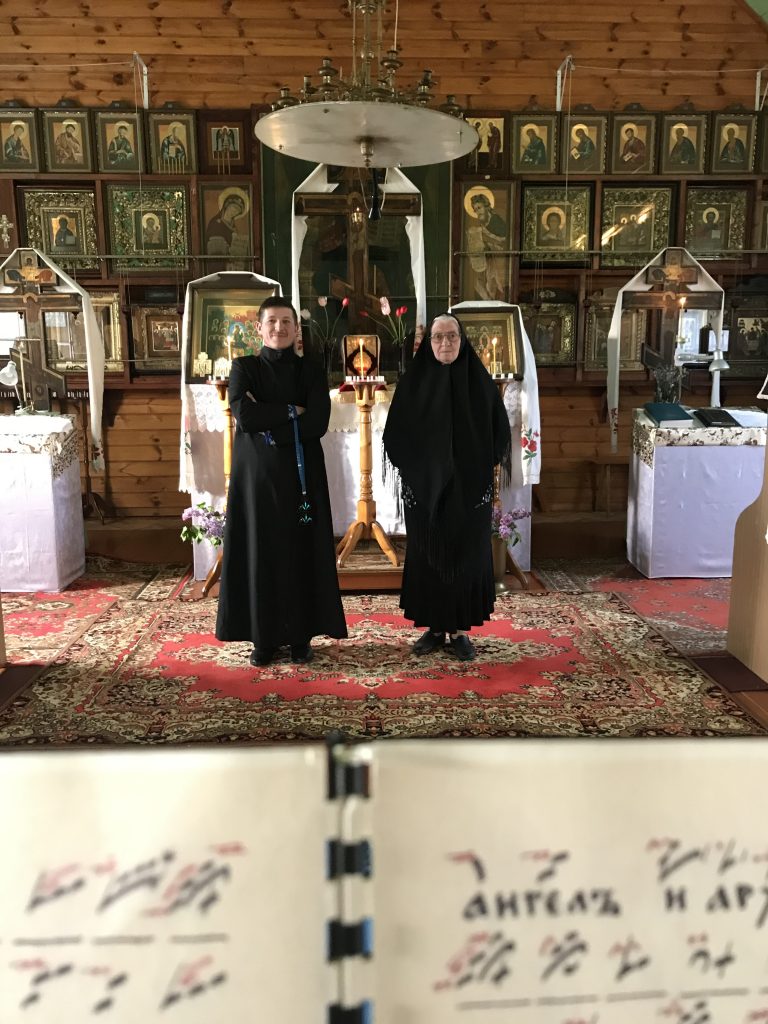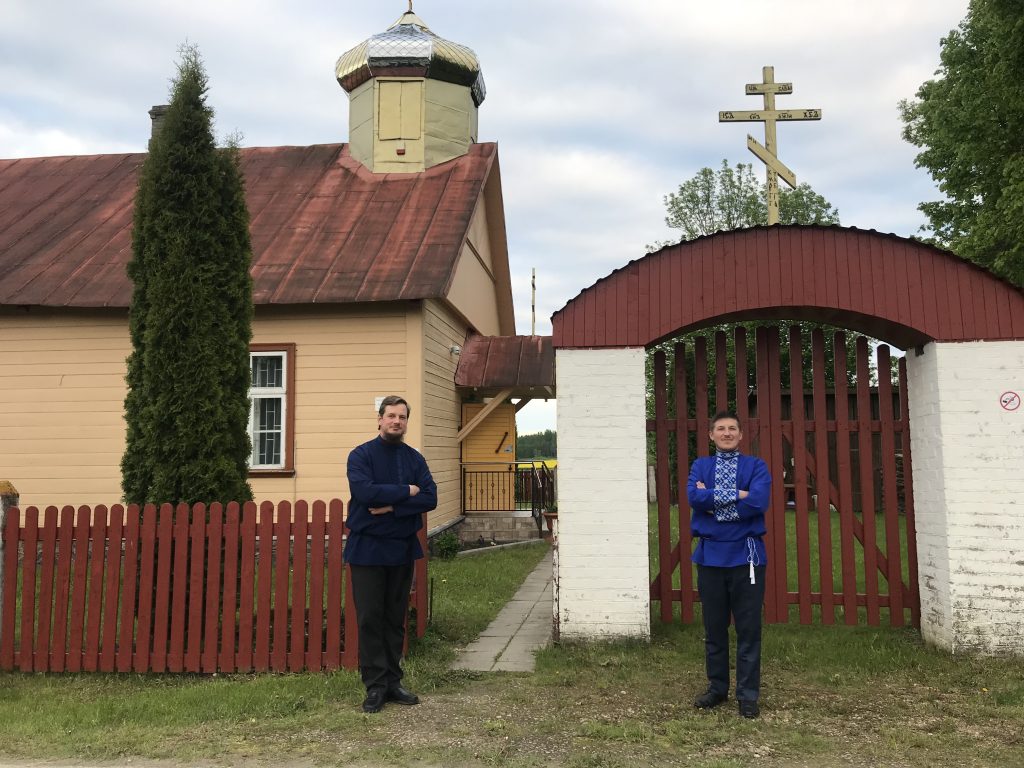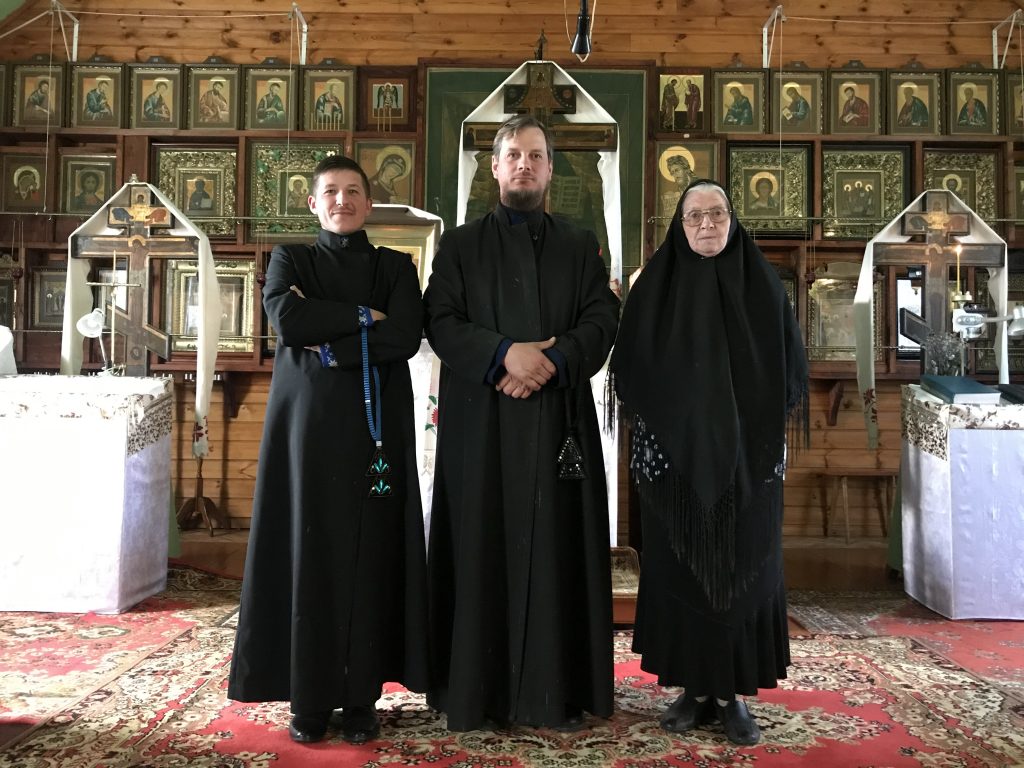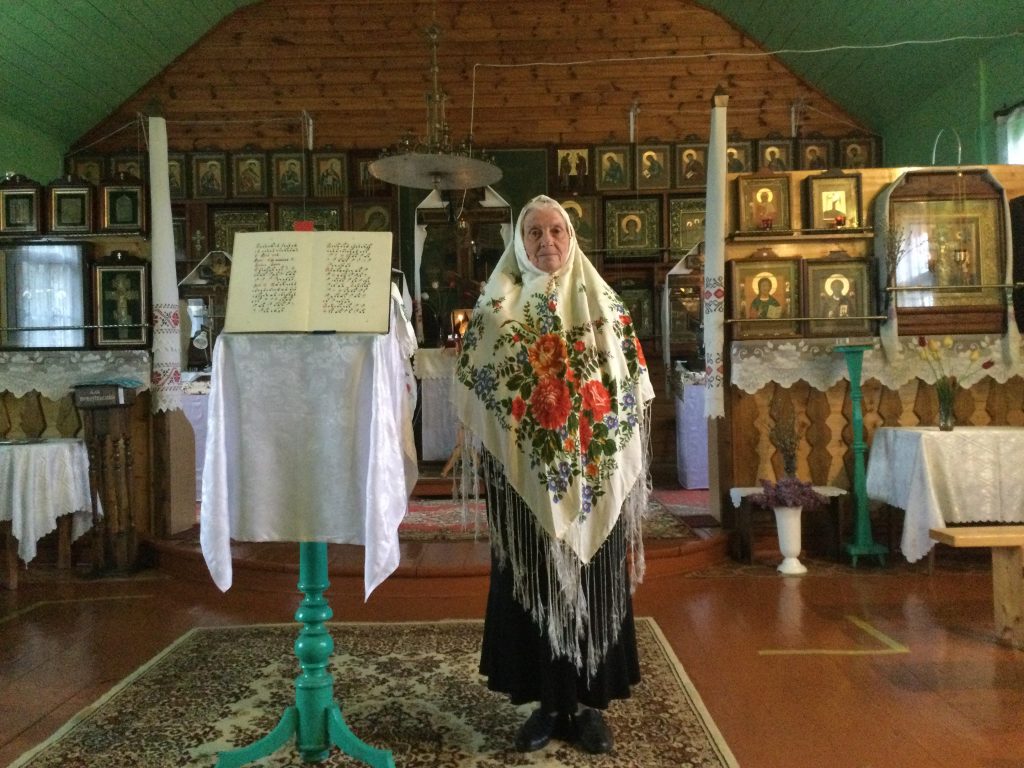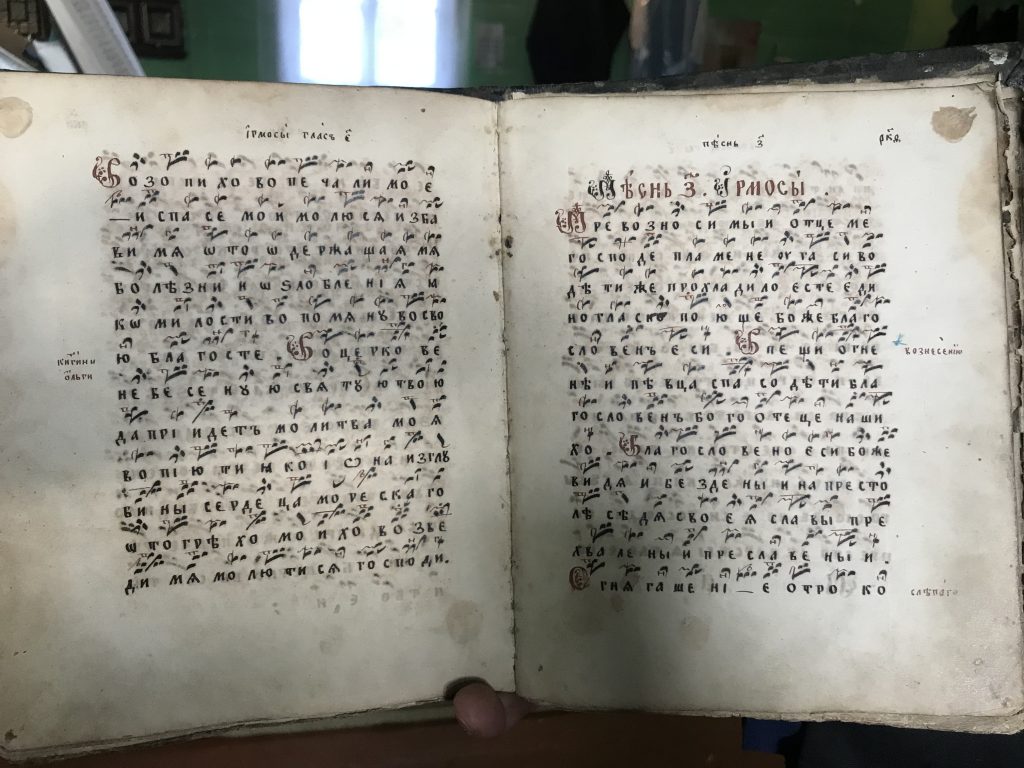Author:
Elvita Ruka
Other domains
Oral traditions and their expressions, including language as a vehicle of intangible cultural heritage
Social practices, rituals and festive events
Music/performing arts
Title
The Tradition of Znamenny Chant (Знаменный распев) Singing in the Pomorian Old Believer Church of Latvia (2022)
“Znamennij raspev” / “Znamennoje peņije” can be translated from the Russian as “sign singing”, and the term shows a connection with the Russian word “Znamja”, meaning “flag”. In this form of sacred music notation, the symbols are often named based on their visual resemblance; the “flag” is one such example. “Krukovoje peņije” (“hook singing”) is so called based on the similarity of individual characters to hooks.
The “sign” or “hook” chants are sacred sung prayers, with roots that can be traced back to Byzantium. However, after reaching a certain stage of development within the Old Russian Church, and following the schism of the Russian Orthodox Church in the mid-17th century, these chants made their way to Latvia, where they evolved into a distinct form. The Latvian Pomorian Old Believer chants represent a unique form of notation and singing.
These chants are performed in Church Slavonic, using specific symbols for their notation. Musical notes are used to represent sound, while the ancient system of signs describes intonation and meaning. The sounds (notes) relate to the secular world, whereas the signs, which have a sacred meaning, document the spiritual, emotional, logical, and musical connections of prayer chants. Each sign represents a movement of the soul. Researchers and bearers of this tradition alike are convinced that it is only in this way that a “genuine and true Christian singing which is always a prayer” can be achieved. The chants are recorded with symbols specifically designed for the purpose and are sung in Church Slavonic, which is used solely in ecclesiastical settings – in prayer chants and in the reading of Holy Scripture. The tradition of “hook singing” has two modes of transmission, which can be conditionally referred to as the “oral” and the “theoretical” or “scholar” type. Those of the former tradition can sing from memory and experience, or based on a particular theme, while the latter, known in Russian as “galavščiki” or “regents”, can read, interpret, and perform all the signs, ensuring their continued transmission – the skills of the latter type are currently the most endangered.
Geography
The Pomorian Old Believer congregations are active throughout Latvia, with the main centre being the Grebenshchikov Old Believer Congregation in Riga (Рижская Гребенщиковская старообрядческая община). It is one of the largest Old Believer congregations outside Russia, and its House of Prayer is the largest Pomorian Old Believer church in the world. Designed by architects Jānis Fridrihs Baumanis and Reinholds Georgs Šmēlings, this sacred art masterpiece took shape in the mid–19th century and is a state-protected architectural and artistic monument that can accommodate around 5,000 worshippers. This is the most spiritually and economically active Pomorian Old Believer centre, which is also home to, among other things, a Spritual school, a publishing house, and a community museum. The Grebenshchikov Old Believer Congregation is unique in that it has a professional choir consisting of six members, the only one of its kind in the Baltic region. It is directed by Jevgenijs Grigorjevs, a leading figure in the theoretical and practical study of these chants, as well as a lecturer, researcher, and author of several books. Other centres with “scholars”, or “regents”, who can provide training are found only in Daugavpils, Rēzekne, Jēkabpils, Viļāni, and Malta. In total, most of the 72 congregations are located in Latgale (6 in Daugavpils, 17 in the district of Augsdaugava, 18 in Rēzekne and Rēzekne district, 10 in Preiļi and Preiļi district, and 7 in Krāslava and Krāslava district), with a few in Sēlija, and some individual congregations in Kurzeme. Geographically, the tradition is most concentrated in Riga and Latgale.
“Sign singing” is a marker of denomination, the key unifying factor being membership in the Pomorian Old Believers’ congregation. Adherents of the tradition emphasise that these chants are a form of prayer, which belong in the church, as part of medieval musicological research, or at certain spiritual gatherings. The Old Believers’ liturgical practices and lifestyle are rooted in early Christian principles and a non-reformed liturgical order. The community’s history of persecution has fostered a certain insularity and ability to remain close to their source of religious strength, with the chanting of signs forming an essential and inseparable part of this tradition.
The Grebenshchikov congregation is unique for housing the only state church choir in the Baltics (and, furthermore, the European Union) which follows the Pomorian tradition; it consists of 6 members. This choir is directed by Jevgenijs Grigorjevs, a leading figure in both the theoretical and practical study of these chants, as well as a lecturer, researcher, and author of several books.
Other centres with “scholars”, or “regents”, who can provide training, are few: Daugavpils, Rēzekne, Jēkabpils, Viļāni, and Malta.
The Pomorian Old Believer community in Latvia has existed for more than 300 years and has managed to safeguard its values. The first Old Believers arrived in the Duchy of Courland and Latgale in 1659. By 1660, construction of the first “Old Orthodox Christian” church had begun. In rural areas, Old Believers lived in secluded parishes, engaging in farming, crafts, and other activities. In cities, they worked in construction and traded. Despite representing a persecuted faith within the Russian Empire, their love for God and work, abstinence from alcohol, and other regulations prescribed by their faith, strengthened the community and increased its prosperity. After Vidzeme was incorporated into the Russian Empire, the number of Old Believers in cities grew. Some were refugees seeking shelter, others were affluent merchants with significant capital, which contributed to industrial development. At the beginning of the 19th century, Riga’s Old Believers purchased the Grīzenberga Manor on the outskirts of the city, where they established their centre (now the Grebenshchikov House of Prayer). In the early 19th century, the favourable economic situation led to a rapid increase in the number of Old Believers: in 1816, Riga had 2,112; in 1826, 5,424; and in 1830, 7,904 Old Believers. Over time, governmental attitudes changed, from favourable to repressive, but the community was and remained united both internally and in their relations with the outside world.
The harshest repressions occurred under Emperor Nicholas I – economic and civil rights were severely restricted, marriages and inheritance rights were not recognised, and schools, almshouses, and other institutions were closed. Pressure to convert to Orthodoxy or Edinoverie (единоверие) was exerted, and the building of new churches was prohibited. To avoid closure, the former Riga Church of the Nativity congregation was renamed after its benefactor Grebenshchikov in 1833. In 1859, attempts were made to shut down the church, but the Old Believers succeeded in preserving it. This centre has always played an essential role in maintaining the “Znamenny chant” tradition.
The situation improved following legislative liberalisation, although discriminatory legal norms were only fully abolished with Emperor Nicholas II’s 1905 manifesto – the former “schismatics” (раскольники) were granted the name “Old Believers” (старообрядцы). Legal amendments facilitated the economic, social, and political activities of Latvian Old Believers, particularly during the period of the Republic of Latvia, when Old Believers achieved equal legal status with traditional denominations and received state funding. During this period, public life flourished, and interest in culture and traditions grew. The Circle of Admirers of Russian Antiquity (Кружок ревнителей русской старины) was established in Riga (1927–1940), with branches in Jelgava, Daugavpils (1928–1940), and Rēzekne (1932–1940), and the Old Believers’ Singing Society in Latvia (Певческое староверческое общество в Латвии), was also founded in Riga (1932–1940). These and other centres educated chant “regents” in Znamenny chanting, and preserved and promoted the oral tradition.
Importance in Community Life
Sacred chants are a form of prayer, the foundation of the community’s liturgical life and a core aspect of this faith’s identity. They constitute at least one third of the service time. Singing is omitted only when there is just one choir member. If there are two or more, the chants proceed in accordance with the regulations of the Order. This means the choir positions itself in the “kliros” (on the right and left sides of the altar) and performs all the chants designated for that particular day. A unique feature of these chants is the dynamic structure of their texts. The way the chants are combined varies according to different time periods – an hour, day, year, as well as lunar and solar cycles – resulting in unique textual arrangements each day. An identical combination of texts would only reoccur after 532 years.
There are 52 Sundays in a year, with 12 major and 10 other feasts. For the full church rite, the choir should sing 74–75 times annually. A regular Sunday service lasts approximately two hours, with the choir singing for at least 45 minutes. During major feasts, the proportion of singing is significantly higher. Aside from services, authentic sacred chants can only be heard at funerals. The majority of singing follows an oral tradition, with only 10–15% of each service consisting of Znamenny chants performed directly from notation. Due to a shortage of regents, oral transmission dominates – that is, singing “from experience”. In the choir, one member (who understands the sign notation) sings from the notation, and others join in. Core texts are memorised, except for the 10–15% that must be sung according to the canonical signs. If no one can read them, this portion is omitted, putting the tradition at risk.
The choir which most consistently observes the sections of “sign singing” is that of the Riga Grebenshchikov Old Believer congregation. A unique feature of this congregation is that it is the only Old Believer church in the Baltic region, and the world, where prayer chants occur every day. The (ideally) full choir performance of Znamenny chants takes place every Saturday and Sunday, as well as on all holidays.
The custodians of the tradition emphasise that the only source of Christian melody should be the words of the prayers themselves.
“In church culture, an individual (physical) sound holds no significance, as it is devoid of a soul. Only the sound and intonation with which the word is chanted has a value and meaning. This melody – the intonation of the word of the prayer – exists as a whole; it cannot be separated from the word, cannot be divided into components. Therefore, church chants consist of complete melodic units – formulas. Each corresponds to a specific idea, Christian principle, or particular spirit of prayer, making it indivisible. In our church, such a formula is referred to as a ‘popevka’ (chant motif)”, states Jevgenijs Grigorjevs, the choir director of the Grebenshchikov Old Believers’ congregation and an authority on sign chanting. He also believes that these chants, in their most ancient expression, cannot be called music, as music relates to the secular rather than the spiritual realm. He points out the linguistic distinction as well: church chants are only “sung” (pojut), while secular music is “played” (igrajut). He also notes the fact that musical instruments have never been used in this church tradition, as they “cannot pray, and, besides, God has created the human voice as the most perfect instrument”. Old Believers’ chants sound solely in unison, and, in essence, improvisation is not permitted. “Church singers never sing anything ‘of their own’ but strive to sing in a manner similar to what has been preserved through the centuries. Following the example, of unison and repetition – this is the true spirit of church singing”.
The main purpose of these chants is not to entertain or gratify people superficially, but to save and heal the human soul, helping it connect with God.
Activities
Sign singing is a component of the church service. To sing, one must master the Church Slavonic language. This is regarded as a sacred prerequisite, as one can only pray in a language in which one does not sin – i.e. does not curse, become angry, covet, gossip, etc.
The manual transcription of sign singing is not relevant nowadays, as ancient songbooks are still in use, both handwritten and printed. At the turn of the millennium, the process became computerised. Several programmes for recording Pomorian Old Believers’ sign singing were developed and implemented specifically in Riga in order to preserve and maintain interest. Unfortunately, the publishers themselves concluded that the demand for this product was almost non-existent. Regents, who are not many, can simply copy these sign transcriptions, while the number of preserved songbooks is more than sufficient.
Beliefs, Rituals, Unwritten Rules
The choir singers are Pomorian Old Believers – this is a mandatory requirement. There are no restrictions on gender or age. The singers are respectable individuals who are capable of managing their sinful nature – they do not smoke, drink alcohol, or engage in other such behaviour. They attend church services dressed appropriately. The women wear long skirts and black scarves (covering their arms) for the normal daily services, and brightly patterned ones on festive occasions. Scarves with fringes are reserved for married women. The colour black symbolises that “the Pomorian Church is like a widow in mourning, and grieves, as the clergy was taken from the Old Believers after the schism”.
The men are clothed in shirts that are worn over the trousers and belted at the waist. The belt symbolises the union of the sinful (below the waist) and the spiritual (above the waist) natures in a person. For this reason, during singing, hands are kept crossed above the waist (to avoid contact with the sinful part). The strictest rules specify that if hands unintentionally fall below this level, they must be washed immediately. When crossing hands, the right hand is always on top, as the faithful strive to sit at God’s right hand after the Last Judgement. Over the shirt, singers wear a long black cloak.
The altar section of the church – the solea – is elevated. Some soleas are straight, while others are rounded, and often there is a special protrusion symbolising the stone on which angels announced Christ’s resurrection. “Anyone can enter the church, but only a few can stand at the front. This is a status akin to that of angels”, explains the regent Grigorijs Zamarajevs.
Inheritance and transmission
Sign singing in accordance with the “napev” (chant motif) or the oral tradition is passed down within the family, the community, and Sunday school. It is a living or folk tradition because these chants are learned through practice, though talent and a willingness to learn are also necessary. In this way, the tradition is preserved over extended periods of time, as well as in each church service. Such an approach also aligns with the principle of early Christianity, where the most important knowledge was passed from person to person, “in living form”. This principle rules out intermediary free-thinking and subjective interpretation. According to the community’s estimates, there could be 200–250 people who sing in a choir using “napev”.
To acquire theoretical or “scholar” level knowledge, a teacher is essential, as well as regular singing – the learning of the tradition also requires a significant time commitment. Currently, there are between 5 and 10 sign-singing regents in the community who have gained this expertise both from the community and through in-depth, long-term training under their mentor. Each of these individuals maintains the oral transmission tradition in their congregation and strives to train a successor. A sign singing course is periodically offered at the Grebenshchikov congregation’s Spiritual school. Unfortunately, interest, especially in recent years, has been minimal – learning these skills is highly demanding and requires specific abilities.
Literature covering the theory of sign singing as well as teaching aids are available in a sufficient quantity (in Russian).
History
The roots of the tradition lie in Byzantine culture, from which the Old Believer Church has inherited two values: the drawing of icons, which is part of the cultural–historical heritage, and sign singing, which is part of the intangible cultural heritage. The eight–mode system, or “voices”, which is the foundation of all chants, was inherited from Byzantium. It reached Kievan Rus before its Christianisation in the year 988. The principle of the eight modes also affirms the deeply sacred significance of chants – God created the Earth in six days and rested on the seventh, while the eighth signifies the symbolic future after Christ’s second coming. Sign singing represents a “second philosophy”, beautiful in the power and constancy of its unison sound. There are accounts that the “angelic” beauty of Greek chants was a decisive factor in Prince Vladimir’s acceptance of Eastern Christianity in Russia.
In the following centuries, sign singing in Russia developed in symbiosis with that of the Greeks, who came to teach the inhabitants of Russia. By mutually enriching one another, sign singing developed in several directions in the “musical laboratories” of Russian monasteries, reaching peaks of mastery by the mid–17th century. This was ensured by professional regents, choirs, and generous court support, which came to an end with the schism of Russian Orthodoxy following the reforms of 1666–1667. These reforms called for modernisation and a rejection of all ancient Byzantine elements, including sign singing, which was also condemned and excluded from the reformed church. In its place came multi-voiced singing, while the Old Believers went into exile, preserving the ancient traditions of chanting. Only the Old Believers have inherited these traditions in their pure, original form. Thanks to their steadfast fidelity (to God’s will), the transmission from generation to generation has been maintained. At the turn of the millennium, the Pomorian Old Believer congregation in Latvia proudly noted that it had 20–25 regents who had fully mastered this significant spiritual singing tradition. In a concert in 2014, the phrase “20 across the entire Baltics” resonated. The uniqueness of these chants was recognised even during the Soviet era, when recordings were collected and published in Estonia, Lithuania, and Latvia. In the years of independence, teaching materials have been published in each country, but CD recordings and a permanent choir with paid singers exist only in Latvia. Therefore, we bear the responsibility for preserving this tradition throughout the Baltics and the world, where there are no other Pomorian Old Believer congregations.
The role and significance of sacred chants within the community has remained unchanged – it is a very important component of its identity.
In current times, the Latvian Old Believers Pomorian Church (Древлеправославная Поморская Церковь Латвии) is regulated by the Law on the Latvian Old Believers Pomorian Church (in effect since 01.05.2008). Approximately 55,000 individuals identify as members of this church, which is organised into 72 autonomous congregations. The Pomorian Church does not have a priest in charge, rather the activities of each congregation are regulated by a council and an elected chairperson of the congregation council. The congregation elects a spiritual leader, who is confirmed by a council convened every five years, coordinated by a centrally elected council. Numerically, this is not the largest religious community in Latvia, but it is well–regulated, strong, and preserves historical traditions both canonically and liturgically. Its refusal to submit to trends of church modernisation and liberalisation has allowed it to maintain the most authentic worship traditions, including sign singing.
Historically, the largest number of adherents by nationality are Russians, Belarusians, Ukrainians, and Latvians married into these families. A modern phenomenon is certain ethnic Latvians’ adherence to this faith, citing as reasons its unchanging spiritual principles and strictest foundations of belief. The community faces challenges in declining rural areas, which affect the number of believers, as well as the economic and demographic situation, where “for every two baptisms, there are twenty funerals”. However, a sharp decline in community numbers has not been observed; the community is considered to be stable. Having survived various periods of persecution, it has found ways to endure throughout the ages.
As regards sign singing, the situation is ambiguous. The oral tradition exists, but there is a lack of those who are educated in its theory, and skilled leaders. The acquisition of sign singing requires: 1) being part of a congregation, 2) musical abilities (particularly a developed hearing), 3) the opportunity to acquire skills and the willingness to do so for several years, 4) material means to accumulate and pass on this knowledge.
Sign singing is one of the most important elements of liturgical practice, as well as an opportunity to preserve a unique tradition. Its existence is necessary for the entire community both now and in the future, but training “scholars” (regents) would also allow for its preservation within the context of the world’s intangible heritage.
Additional Information
Sacred chants exist only in connection with knowledge of the Holy Scriptures, which the bearers of oral tradition acquire as participants in the liturgy, but regents study more intensively, either at the Grebenshchikov Spiritual school or independently, and at other church-approved spiritual schools in Latvia and abroad.
Masters
Jevgenijs Grigorjevs, the regent of the Grebenshchikov Old Believer Choir, author of several textbooks and studies, and lecturer at the Spiritual School, is currently 56 years old and has served in the church since the age of 16; he has never worked in a secular job. He has experienced the resurgence of the national awakening, which also applied to sign singing and a heightened interest in traditions, as well as the decline in enthusiasm. He is an active “professional level” preserver of the tradition.
Aleksejs Ravinskis and Jevgenijs Fedorivičs (Riga): contemporaries of Grigorjevs and Riga choir singers: regents.
Andrejs Burdins: the regent and pastor of Rēzekne, under whose leadership a choir operates: he has one “full–time” apprentice.
Georgijs Zamarajevs: the pastor and regent of the Daugavpils Jaunbūve and Endželi (Jēkabpils district) congregations, an active enthusiast and expert in sign singing with a musical education, passion, and perfect command of the Latvian language.
Aleksejs Voronovs: the regent and pastor of Viļāni, who keeps the tradition alive.
Institutions and Organizations
Latvian Old Believer Pomorian Church:
Grebenshchikov congregation in Riga,
Viļāni congregation,
Endželi congregation,
Rēzekne congregation,
Daugavpils Jaunbūve congregation,
as well as others, where sign singing is practiced and where there is an opportunity to learn it in greater depth.
Strengthening the Tradition
Congregations operate with a vibrant oral transmission tradition.
In some congregations, the pastor is also a regent and transmits the tradition as much as possible.
A paid choir of six people operates at the Grebenshchikov Old Believers’ House of Prayer – the only professional choir in the Baltics.
Since the restoration of independence, several books have been published, as well as teaching materials. A series of lectures has been prepared on the theory and practical acquisition of sign singing.
In Daugavpils, the only Pomorian Old Believer choir in the Baltics, UNISON, existed, which recorded a CD and gave a highly praised concert at the Jāzeps Vītols Latvian Academy of Music in 2014. Unfortunately, the choir and community leader Aleksejs Zilko passed away in 2021, leading to the choir having to suspend its activities.
The tradition of sign singing ensures the identity and existence of the community. Sign singing remains a part of the community’s core values, but the lack of knowledgeable individuals raises concerns about the future transmission of this complex heritage. It is encouraging to see some energetic enthusiasts of sign singing who are gathering a circle of potential successors to these skills around them.
Funding in the form of a targeted grant or a donation specifically for sign singing has not been received from either local authorities or state institutions. However, the church as a whole does receive various forms of assistance. This support varies depending on specific municipalities and needs. Most often, it is for church repairs and maintenance. The community actively organises scientific and research events, holds conferences, and is active in publishing, each of which, at different times, has received support from the state or local authorities. Otherwise, the church sustains itself through donations and income from property rentals and other economic activities.
The congregation itself tries to support the regent, the choir, and the tradition of sign singing from joint finances. The possibilities depend on the parish’s resources, which vary greatly between Riga and the smaller churches.
Financial support specifically for maintaining the tradition of sign singing is granted for those ministers who are regents, and financial support is also granted for the Grebenshchikov Old Believer choir. All payments are made by the church from its internal funds.
In the future, for certain projects related to this tradition, the possibility of seeking state support from the SCCF, the Integration Fund, or other specialised funds is being considered.
Continuity/Development
Care for the ongoing preservation of the tradition will be the responsibility of the Grebenshchikov Spiritual school, an educational institution for Old Believers in Riga. A specialist will be recruited and employed to oversee the continuation and development of the tradition. This specialist will carry out the following tasks:
1. Organise meetings of regents and assess the current situation within the community.
2. Coordinate the recording of the best choir performances.
3. Record interviews with regents, transcribe them, and ensure their publication in the Latvian language.
4. Ensure that teaching materials and the best descriptions of the tradition are translated into the Latvian language.
5. Encourage and assist in creating an exhibition space dedicated to sign singing at the Old Believer Museum in the Grebenshchikov House of Prayer; organise a public event for a professional audience.
6. Promote or personally create publications about sign singing in the press and other media.
The Pomorian Old Believers’ congregation and the Grebenshchikov Spiritual school will coordinate events for the protection of the tradition:
1. Emphasis will be placed on Sunday schools and youth, selecting the most capable individuals.
2. Efforts will be made to provide scholarships for students of advanced sign singing studies across Latvia.
3. Within the framework of the Spiritualschool, lectures will be organised to educate and promote the tradition.
4. In ideal circumstances (if there are interested parties), a separate course on sign singing will be established within the curriculum of the Spiritual school.
5. The most important task is the preservation of the Grebenshchikov Old Believers’ Church Choir.
6. Preparation of materials for remote learning of the tradition.
1. Increase the prestige of acquiring theoretical knowledge of sign singing and pass on the skills.
2. Within five years, train at least five new regents in different congregations.
3. Preserve the tradition in a high-quality form, without losing the unique knowledge of previous centuries and its practical application.
4. Reveal this lesser-known part of intangible cultural heritage to a wider audience.
5. Position Latvia as a tolerant country that respects and protects the diverse intangible cultural heritage of the various people living within its territory.
6. Highlight the Old Believer heritage preserved in Latvia on an international level: specifically, 1) the number of churches in Latgale, which is unique on a global scale, 2) the tradition of Znamenny chant, in which we are the strongest in the Baltics and the world.
Threats to the Tradition
At the professional level, the main threat is the reduction in the number of existing bearers of the tradition, namely regents and their apprentices.
At the level of folk or oral traditions, the number of choir members is slightly decreasing, and without a knowledgeable regent, singing is only performed using “napev”, leading to the loss of the skill to sing using signs, and the tradition becomes simplified and diluted.
The economic situation affects the amount of time people can dedicate to the church and its rituals, including learning chants. For young people and those in the prime of their working lives, the priority is ensuring their livelihood and well–being, leaving the church more in the care of the elderly.
The political situation influences community activities, encouraging a cautious outlook. Centuries of survival tactics have taught Old Believers to avoid standing out, refrain from drawing unnecessary attention, and to keep to themselves.
“There are few men and spiritual education is lacking”.
Applicant
The Pomorian Church of Latvia's Old Believers.
Photo Gallery
Audio Materials
Video Materials
Websites
Documentary film "In the Footsteps of the Old Believers of Mezare," 2018 - a film produced by the Mezare parish association “ELPAS” about the history, churches, and traditions of the Old Believers in this parish. Stories have been heard and recorded, events have been captured, rituals clarified, and the rich cultural heritage of the Old Believers has been unveiled, with a particular emphasis on the tradition of sign singing. One of the film's protagonists is Georgijs Zamarajevs – the spiritual leader and regent of the congregation.

